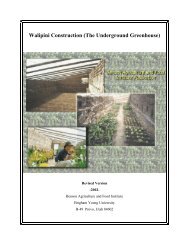GUINEA PIG MANAGEMENT MANUAL - Benson Institute
GUINEA PIG MANAGEMENT MANUAL - Benson Institute
GUINEA PIG MANAGEMENT MANUAL - Benson Institute
Create successful ePaper yourself
Turn your PDF publications into a flip-book with our unique Google optimized e-Paper software.
Figure 3: Reproducing guinea pig from the “NUEVA TAMBORADA” lineage<br />
The positive productivity characteristics that this species shows are the following:<br />
• Rusticity and easy management<br />
• Short biological cycle<br />
• Early sexual maturity<br />
• “Neonato al medio” immediate response<br />
• Varied feeding mixtures (alfalfa, corn, barley, oats, etc.) harvest leftover (corn leaves,<br />
barley straw, oats, beans, etc.) kitchen crumbs, industrial sub products (wheat bran, soya<br />
flour, sunflower, cotton cake, etc.).<br />
• Guinea pig droppings are sub products that are great organic fertilizers<br />
II. BREEDING SYSTEMS<br />
Guinea pig breeding in Bolivia is managed under three systems that are characterized by their<br />
function in the productive unit, which are: family breeding system, commercial family breeding<br />
system, and commercial family breeding system.<br />
FAMILY BREEDING<br />
The family breeding system is the most predominant in our area. The system’s principal<br />
function is auto consumption and special cases to generate income. Sales are made when there is<br />
4



